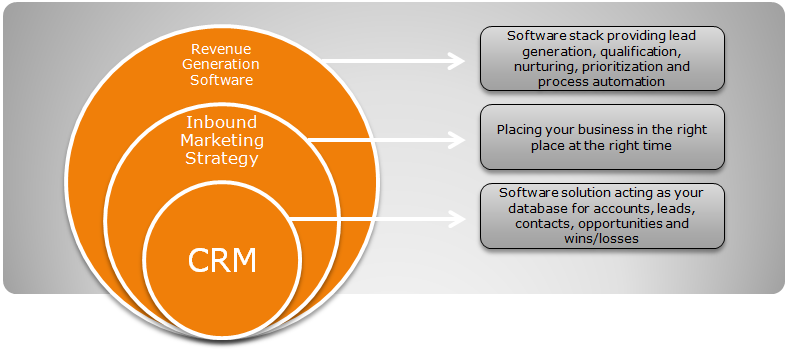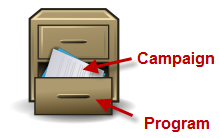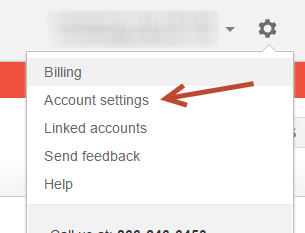Lead Liaison 101
This document discusses basic terminology used across Lead Liaison. It covers Programs, Campaigns, Lead Sources and compares these components to other components you might be familiar with. A comparison of the revenue cycle to the standard sales cycle and known leads to unknown leads is also provided.
What is Revenue Generation Software®?
Revenue Generation Software® is a sales, marketing and executive solution that helps your business generate, accelerate and measure revenue across all phases of the revenue cycle. Revenue Generation Software® is a platform, not a feature or product. Revenue Generation Software® includes the following core capabilities:
- Lead generation
- Tracking
- Qualification
- Nurturing
- Lead prioritization
- Lead distribution
- Website personalization
- Marketing program analysis
Three key components typically exist in a business marketing system, Revenue Generation Software® (RGS) being one of them. A CRM system, such as Salesforce.com, typically sits at the core of any business. A CRM is typically used and perceived as a large database to keep track of accounts, leads, contacts and opportunity wins/losses. CRM reporting typically provides a snapshot in time of business data.
The second component of a business marketing system is an inbound marketing solution/strategy. Inbound marketing is the process of placing your business in the right place at the right time. Facebook, Twitter, LinkedIn, blogging, landing pages and more are all examples of inbound marketing strategies. The concept is to know where your buyers "hang out" and how they research so you can get your business in front of your buyers, and be there when they're ready to take the next step.
The third component is RGS which provides operational advantages for your business. It helps to automate typical sales and marketing processes that historically took time to do manually. It's important to note that a CRM system and RGS are not the same. They are not competitive technologies, they are complimentary technologies. A CRM provides great tracking, storage and static views whereas RGS provides dynamic views and establishes sales and marketing processes, procedures and key operations that give businesses a competitive advantage in their marketplace.
Known vs Unknown
A Known Prospect in Lead Liaison is someone with an email address. An Unknown Prospect is someone who does not have an email address. An email address is the unique identifier used in Lead Liaison. No two Prospects will have the same email address in the system.
Defining Programs, Campaigns and Lead Sources
- Program: A collection of Campaigns.
- Campaign: A descriptive name for a marketing effort. Each prospect may be associated with multiple campaigns.
- Campaign Type: Describes a high-level categorization of campaigns such as Email marketing, Surveys, Tracking URLs, Automations, etc.
- Lead Source: Typically mirrors the Campaign Type with a few extra and custom values to keep track of leads that do not come in through Campaigns. For example, a Lead Source may match Campaign Type for values such as a Trade Show, Email Campaign, AdWords Campaign but you can use additional values such as "Employee Referral" or "Customer Referral" to track leads that come into your CRM, such as Salesforce.com, through channels other than formal Campaigns.
Programs vs Campaigns
Lead Liaison uses a concept of Programs and Campaigns to organize and create marketing activities. A Program is a collection of Campaigns. The Program/Campaign concept is similar to a file cabinet. The drawer of a file cabinet would be your Program whereas the file(s) in the drawer would be the Campaign(s). Marketers first create a Program, give it a name, then add Campaigns to their Program.
Campaigns are individual marketing events such as an email campaign, webinar or trade show. Lead Liaison helps marketers build multiple different types of campaigns. See "Types of Campaigns" below for a list of possible Campaigns that can be created. When creating an asset, such as an email, trackable content, web form, etc. assign the asset to your Campaign. Start creating Programs and Campaigns by clicking the new button on the top once you've logged into Lead Liaison.
Lead Sources vs Campaigns
Lead Liaison automatically assigns (tags) all leads with a lead source when possible. It is important not to confuse a Lead Source with a Campaign. Here's a short comparison chart to help you understand the difference between a Lead Source and a Campaign:
Feature | Lead Source | Campaigns |
|---|---|---|
Tracks leads from many places | YES | NO |
Designed to track what marketing is doing well | YES | NO |
Refers to all possible ways you receive an inquiry | YES | NO |
Helps calculate cost of acquiring new leads/customers | NO | YES |
Designed to track effectiveness of marketing programs around products/services | NO | YES |
Usually has a budget associated with the event | NO | YES |
Lead sources tell you the source of a lead and does not provide information about the expense/cost spent; however, a campaign can help you with more detailed information about the source. Leads can come from many places and a Lead Source refers to all possible ways you receive an inquiry - a phone call, an e-mail inquiry from our web site, a referral from an existing customer or a reply to a specific marketing campaign. For example, one of your customers might tell someone about your product or service at which time the new prospect contacts you directly. Your sales person would likely add "Customer referral" as the Lead Source in their CRM. Similarly, one of your salespeople may be using a list to cold call prospects until they find a hot lead. Your sales person would likely add the name of the cold calling list as the Lead Source. Some companies like to track the source of new leads so that they can understand what aspects of marketing is doing well and what aspects of marketing they need to improve on.
A Campaign is a specific initiative designed to market your company's product and/or service. It could be something as simple as a single direct mailer you send to an existing lead, existing customer or a list of people. Alternatively, a collection of Campaigns can comprise a multi-step Program of webinars, email messages, or direct mail with different materials sent out at specific time intervals. Campaigns usually have a budget and companies track which contacts have been influenced by their marketing campaigns to measure return on the investment for each campaign. By doing so, companies can evaluate which campaign elements are most effective and adjust them as necessary.
For more information on Lead Liaison's lead source tagging process reference this wiki page.
For more information on Programs and Campaigns reference this wiki page.
Lead Sources
First, it's helpful to understand what a query string is. Check out this URL:www.leadliaison.com/?source=email
In that example, "source" is a "field" and "email" is a "value." Here's another example:
www.leadliaison.com/?source-two=second-email&source=email
That example has two query strings. If you have multiple query strings in a row, they're connected with the ampersand. You can learn more about query strings on Wikipedia if you're interested.
It's also helpful to understand what a referring URL is. When someone clicks on a link to your website from an external website it's possible to determine which web page contains the link to your website. That external webpage is called the "referring URL."
PPC Lead Source Tagging
Lead source tagging from Lead Liaison will only work if you enable auto-tagging in your PPC account. To enable auto-tagging for Google AdWords for example, do the following:
1) Login to your AdWords account at https://adwords.google.com
2) Go to Account settings
3) Under the Tracking section enable Auto-tagging
* Also, make sure to link a Google Analytics account to your Google AdWords account. Instructions can be found here: http://adwords.google.com/support/aw/bin/answer.py?hl=en&answer=146820. If your Analytics account is under a different Google Account then add a new user with account administration rights to your Analytics account. Once that's done you can link your Analytics account to your AdWords account.
If Analytics is not linked to AdWords lead source tracking may not work. Specifically, the "gclid" parameter will not show up in the landing page link (see Lead Source Rules for "Paid Search (PPC)" below)
References:
Lead Source Rules
In general, the first thing we check for is whether there is a query string for "source=". If that value contains the word "email" then the visit is an Email Marketing campaign. Note that it doesn't have to be an exact match. The value just has to contain the word "email". Examples like "source=email-2011-06-01" and "source=060111-email-leadtracking" and "source=060111emailleadtracking" are all matches as Email Marketing campaigns. If the "source=" value contains "adword" or "ppc" or "cpc" we call the Lead Source of the visit a "Paid Search (PPC)". We add another layer of depth to identify what pay per click engine is used. For example, we identify Google, MSN and Yahoo! PPC engines as "Paid Search (PPC) - Google", "Paid Search (PPC) - MSN", "Paid Search (PPC) - Yahoo!" if the source value in the Landing Page Link also contains "google", "msn" and "yahoo" respectively. Let's use the example below. If this is the Landing Page Link then the Lead Source value would equal "Paid Search (PPC) - Google".
http://www.yourcompany.com/?source=googleppc&utm_medium=cpc&utm_source=google&kw=somekeyword&kmas=1&kmca=something&kmag=somethinghere&kmkw=www.website.com&kmmt=e&acnw=g&acap=1t1&gclid=CMTCpb2Xsb0CFc1cfgodMLYA6Q
Lead Liaison allows the addition of custom values. For example, if you had a specific trade show that you wanted to track and every link in the tradeshow follow up email contained "source=customvalue" our system will auto-tag your lead with the custom Lead Source type.
Next, we look at the query strings for "utm_source=", "utm_medium=", and "utm_campaign=". We follow the same rules for those as we did for "source=".
The next area of lead source analysis is the referring URL. If the referring URL contains "facebook.com" we mark the Lead Source as "Facebook". If the referring URL contains "twitter.com" we mark the Lead Source as "Twitter".
Landing Page Link = URL of a page on your website
Referral Link = URL of a 3rd party page that contained a link to your website
Destination URL = Used by Google AdWords. The destination URL is the exact URL within your website that you want to send users to from your ad.
Display URL = Website address that's displayed on your Google AdWords ad.
Lead Source | Assignment Rules |
| Custom Lead Source from a Lead Liaison Tracking URL | If the Landing Page Link contains the "llcmpid" parameter. Note, if the Landing Page Link was generated from a Lead Liaison Tracking URL the Lead Source will already be defined as entered by the user when setting up the Tracking URL. Lead Source's from Tracking URLs take precedence over any of the rules in the table below, which define how Lead Liaison auto-tags the lead with a lead source. |
Email Marketing | If the link visited contains the "llsubId" parameter. This parameter is added to all links sent through individual email marketing messages (not part of an automated workflow). This behavior indicates the recipient clicked a link sent from a mass email. |
Lead Nurturing | If the link visited contains the "llsubId" AND "lead_nrtr" parameters. These parameters are added to all links sent through an automated workflow. This behavior indicates the recipient clicked a link sent from an automated email. |
Email Plug-in | If the link visited contains the "em" parameter and the value of this parameter is a valid email address. The email address is Base 64 encoded. This behavior indicates the recipient clicked a link sent from a Send & Track email. |
| Paid Search (PPC) - Google | Same as below for "Paid Search (PPC)" AND if the Landing Page Link "source=" value contains "google". |
| Paid Search (PPC) - MSN | Same as below for "Paid Search (PPC)" AND if the Landing Page Link "source=" value contains "msn". |
| Paid Search (PPC) - Yahoo! | Same as below for "Paid Search (PPC)" AND if the Landing Page Link "source=" value contains "yahoo". |
Paid Search (PPC) | 1) Referral Link "source=" field contains the word "adword" or "ppc" or "cpc" OR |
Organic Search (SEO) | Visitor not from PPC AND the Referral Link is an identified search engine (there could be Search Words or NO search words, it doesn't matter) |
Social Media | Referral Link contains any of the Top Social Media Websites or the word "blog". For example, if Referral Link contains "twitter.com" (or "t.co") or "facebook.com" |
Direct Traffic | Referring Link is empty AND there is no relevant query string. Also indicates direct traffic. |
Other Campaigns | 1) Landing Page Link contains "utm_source=" AND "utm_medium=" AND "utm_campaign=" is present (and of course it doesn't contain adword or ppc or cpc) OR |
Referrals | Referring Link is from other domains (not a search engine, social media site, etc.) AND none of the above rules were met. |
For Google AdWords:
Google AdWords ad's automatically add a gclid parameter to the destination URL.
The "gclid" parameter used in auto-tagging will show up in your landing page URL when a user arrives at your site from your ad. For example, if your site is www.mysite.co.uk, when a user clicks on your ad it will appear in the address bar as:
www.mysite.com/?gclid=123xyz
Top Social Media Sites for "Social Media" Lead Source Tagging
If a lead comes from any of the following top social media sites the lead source is tagged with "Social Media". Rankings are based off of Alexa ratings as of 2011.
Number | Website | Alexa Ranking | Category |
1 | facebook.com | 2 | General |
2 | youtube.com | 3 | Videos |
3 | twitter.com | 9 | General |
4 | linkedin.com | 17 | General |
5 | flickr.com | 31 | Images |
6 | stumbleupon.com | 113 | Cool Content |
7 | reddit.com | 136 | General |
8 | digg.com | 140 | General |
9 | scribd.com | 199 | Articles |
10 | del.icio.us | 244 | General |
11 | metacafe.com | 285 | Videos |
12 | technorati.com | 901 | Blogging |
13 | mixx.com | 2,265 | General |
Search Engines Used for Lead Source Rules
Here is a list of search engines tracked/identified by our tool:
- altavista
- aol
- ask
- dmoz
- kanoodle
- msn
- teoma
- bing
- yahoo
References
Related content
© 2021 Lead Liaison, LLC. All rights reserved.
13101 Preston Road Ste 110 – 159 Dallas, TX 75240 | T 888.895.3237 | F 630.566.8107 www.leadliaison.com | Privacy Policy




